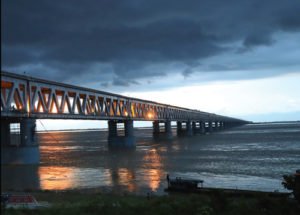 Bridging River Brahmaputra has always been a daunting task, the river has been traditionally considered extremely difficult for bridging due to various reasons including its ferocious & unpredictable behaviour, high currents & turbulent waters, widespread erosion of the banks, very short working period & high seismicity and remoteness of the area.
Bridging River Brahmaputra has always been a daunting task, the river has been traditionally considered extremely difficult for bridging due to various reasons including its ferocious & unpredictable behaviour, high currents & turbulent waters, widespread erosion of the banks, very short working period & high seismicity and remoteness of the area.
With the width ranging from 1.2km to 18km, Brahmaputra river has been bridged four times in past. Hindustan Construction Company Ltd (HCC) holds a distinction of building three of these bridges and the latest among them is the bridge at Bogibeel, near Dibrugarh.
Saraighat Bridge in Guwahati was the first rail-cum-road bridge over mighty Brahmaputra river in Assam. Although the first railway line in Assam came up in 1881, yet Brahmaputra was not bridged by the British. It was bridged by HCC by building the 1.3 km long bridge at Saraighat near Guwahati. This bridge was opened to traffic in April 1962 by then Prime Minister Jawaharlal Nehru. Recently, a new road bridge has been constructed at Saraighat which 1.49km is long and was inaugurated in 2017.
Kolia Bhomora Setu at Tezpur was the second bridge constructed by HCC. This pre-stressed concrete road bridge connects Sonitpuron the north bank with Nagaon district on the south bank. The length of this bridge is 3015 m, and its construction went on from 1981 to 1987.
Bogibeel Bridge
Bogibeel Bridge is a combined road and rail bridge in the Dibrugarh district of the North Eastern Indian state of Assam. The 4940.5m long bridge is the longest bridge of its kind in India which provides connectivity to nearly five million people residing in Upper Assam and Arunachal Pradesh. It also gives easy and direct access to the upper Assam from the rest of the country through the North bank, in contrast to the current route through Guwahati in the South bank which is long and tortuous. Due to its location, the bridge is of strategic importance to India as it will significantly enhance India’s ability to transport troops and supplies to its border in Arunachal Pradesh.
HCC in joint venture with DSD Brouckenbau GmbH, Germany and VNR Infrastructures Ltd received the order from Northeast Frontier Railway to construct the superstructure of Bogibeel Rail-cumroad Bridge in November 2011. Bogibeel Rail-cum-road Bridge is a double decked bridge having two railway tracks on the lower deck and a three-lane road on the upper deck flanked by footpaths on each side. Highway alignment meets the top level of road deck of the bridge suitably beyond the abutments while the rail alignment continues in the same line and level.
Location
The Bogibeel Bridge, situated 17km downstream of Dibrugarh and Dhemaji, spans the Brahmaputra river and connects the town of Dibrugarh in the south to Dhemaji to the river’s north. The bridge is located just over 20 km away from the Assam-Arunachal Pradesh border and is thus expected to act as an alternative to the Kolia Bhomora Setu, Tezpur in providing connectivity to nearly five million people residing in Upper Assam and Arunachal Pradesh
Bogibeel is the fifth rail-road bridge on the Brahmaputra river in Assam. Due to its location, the bridge has strategic importance to India as it significantly enhances India’s ability to transport troops and supplies to its border with Tibet in Arunachal Pradesh. Being located in an area of intense rainfall, construction has been significantly challenges.
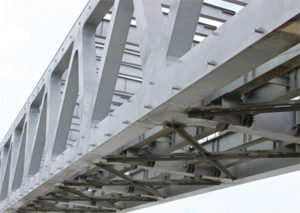 Rail connectivity
Rail connectivity
The bridge provides a connection between the Rangia-Murkongselek section of the North East Frontier Railway on the north bank of Brahmaputra and Lumding– Dibrugarh section that lies to the south of the Brahmaputra. A New Dibrugarh Railway Station, expected to be the largest in the region, has been proposed and is to be linked to the Rangia-Murkongselek line via Chaulkhowa and Moranhat. The Railways has initiated the gauge conversion of the Dhamalgaon to Sisiborgaon rail line to the north of the bridge and commissioned the 44 km Chalkhowa-Moranhat line to the south.
Project History
The project obtained approval of the federal Cabinet Committee on Economic Affairs (CCEA) in September 1997 and construction began in April 2002.
For the purpose of building the bridge, Indian Railways had to construct the expanse of the Brahmaputra river from 10 kilometres to five kilometres. This involved construction of ‘guide bunds’. The project required about 505 hectare of land, which was acquired across 19 villages. Major earthworks and strengthening of the north and south dykes were completed by June 2011.
Advantages of Welded Bridge
Bogibeel is India’s first and only fully welded bridge construction. It is also for the first time European codes & welding standards were adhered to in the construction of a bridge in India.
Normally in a steel bridge construction, bolts & rivets are used, which need periodic replacement due to shear failure over traffic loads. Construction of trusses using welding makes the connection between the components a permanent one, thereby eliminating the above failures. Welded bridge not only reduces the maintenance cost but also adds to the longevity of the superstructure. It is estimated that Bogibeel Bridge is durable and serviceable for 120 years.
This post is sponsored by our partners Wigs
Construction Methodology
 For the construction of this mammoth bridge, HCC had set-up huge facilities on the left bank of the river that had three sequences of Fabrication, Assembly and Launching.
For the construction of this mammoth bridge, HCC had set-up huge facilities on the left bank of the river that had three sequences of Fabrication, Assembly and Launching.
Fabrication: The Fabrication Shops of 2000 MT per month capacity were set-up with two parallel Bays. The team had assembled customized platforms in-house to fabricate and fit various joints employing Gas Metal Arc Welding (GMAW). To ensure an errorfree welding – Magnetic Particle Testing, Dry Penetration Testing and Ultra Sonic Testing were deployed. A specialized Beam making CMM Machine from Italy is used for the first time in India for fabrication of Box and I-Sections using Submerged Arc Welding (SAW) procedure. A blasting gun was used to achieve the surface roughness of SA 2½ before applying paint. The Intermediate and final spray coatings are performed in a highly controlled climatic chamber with spray guns.
Assembly: Thereafter these fabricated sections were moved to the assembly shop where they installed on their designated beds. They are guided to their correct positions through jacking and welded by GMAW process. These segments are arranged in a sequence and sent for the vertical assembly using horizontal lifters. After installation of the top and bottom girders, the final Truss Bridge Dimension Design Chambers are examined thoroughly and approved to complete the fit out. A Nose is fabricated and fitted on the first truss before launching it on the piers.
At the Bogibeel project, the HCC team used ‘Most 2D’ automatic nesting software to generate efficient twodimensional cutting plans for fabricating the steel superstructure for the bridge. The nesting technology was based on advanced cutting algorithms specifically designed to optimise the cutting layouts in shearing. The software generates highutilisation layouts, significantly reducing waste and maximizes productivity.
 Launching: While determining the methodology of erecting the steel trusses on pillars, engineers had two choices — lift the spans with floating cranes or erect them with a launching truss. And they have to decide based on which option would be proved more practical and economical.
Launching: While determining the methodology of erecting the steel trusses on pillars, engineers had two choices — lift the spans with floating cranes or erect them with a launching truss. And they have to decide based on which option would be proved more practical and economical.
After weighing the pros and cons, the HCC team came-up with a solution of pulling the steel trusses with a set of jacks and winches on the pillars. This eliminated the need to enter the river, which was often turbulent during monsoons. Besides, it also ensured safer working conditions, precluded the mobilisation of giant setup on either side of the river having a width of 4.8 km and accelerated the pace of the project. The strategy is a testimony of the company’s value engineering, an important feature of the globally-practiced ‘Lean Construction’ that is changing the way projects are executed from design to construction.
A 1000 tonnes hydraulic jacks and strand jacks linked with the substructures were used for moving the steel truss over the pillars. Two sets of steel cable strands were anchored to the end cross beams of the Truss and hauled by hydraulic jacks. The Truss slides over the Launching Bearing with the help of Sliding Plates, which were inserted at one end and taken out at the other, thereby moving the Truss towards its desired position. In order to limit the required launching forces, the superstructure was pulled in four launching segments of 10 spans each. Thus the superstructure was pulled over the pillars just like a train of ten spans. With each span weighing 1700 MT, the pulling force required was equivalent to pulling 26 Airbus A380 with maximum takeoff weight over 650 tonnes, put together without any wheels.
Finally, the launching bearings were replaced by final bearings. The tracks were laid and the road was constructed adapting RCC construction. After fulfilling the electrical and other ancillary requirements, the assignment was completed.
Supply-Chain Management
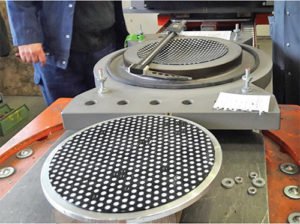 Construction supply chain is a network of suppliers, manufacturers, assemblers, sub-contractors, retailers, customers and other stakeholders. The main objective of effective supply chain management is to reduce the handling costs and on-site storage. Enterprise Resource Planning (ERP) solutions, such as System Applications & Products (SAP), implemented at all HCC project sites offer flexibility in material planning as per the construction sequence and help overcome challenges during execution. This, in turn, minimises the idling time of equipment and material inventories and enhances the efficiency of operations.
Construction supply chain is a network of suppliers, manufacturers, assemblers, sub-contractors, retailers, customers and other stakeholders. The main objective of effective supply chain management is to reduce the handling costs and on-site storage. Enterprise Resource Planning (ERP) solutions, such as System Applications & Products (SAP), implemented at all HCC project sites offer flexibility in material planning as per the construction sequence and help overcome challenges during execution. This, in turn, minimises the idling time of equipment and material inventories and enhances the efficiency of operations.
HCC follows the Just-In-Time (JIT) inventory system where it produces or acquires materials and products as per demand. This is a key component of its supply chain.
At the Bogibeel Bridge project, the team used a combination of rail and road transport to deliver 80,000 tonnes of steel plates from various parts of the country to the remote project site in Assam.
Steel plates and sections were procured mainly from three sources i.e. JSPL, Essar & SAIL. Of these 80,000 MT, approximately 20,000 MT (25% scope) was categorized as ODC (Over Dimension Cargo) and attracted special measures for transport to the project site from the sources in Hazira and Angul which were more than 3200 km and 1800 km away respectively. The average lead time of procuring these materials is four months. Procurement plan was made according to minimum order quantity required for thickness-wise also estimating future market price trends as the order lot sizes ranges from 3500 MT to 10000 MT.
Spherical bearings were inspected at Germany, shipped to China for load testing and then shipped to Bhopal for the refitting of tested bearings and then finally shipped to project site. The lead time of such consignments is six months. Average daily consumption of welding wire was to the tune of 2000kg per day; Grinding wheels around 5000 per day; Argon + Co2 shielding gas more than 200 cylinders per day; O2 cylinders around 500 per day and around 50 BMCG cylinders per day. Besides 4,50,000 Shear studs were imported from Nelson, USA, (lead time of 3 months), High Strength Friction Grip bolts for around 7,00,000 quantity were manufactured at different sources in India and Diamant MM1018FL gap compensation were imported from Germany (lead time of three months).
The fabrication of various components, using reinforcement bars and plates, has become an integral part of infrastructure projects. Advanced software is used to determine the optimum sizes of bars and plates before procurement, thereby reducing wastage and volume.
Spherical Bearings
 Railways has traditionally used steel rocker-roller bearings for bridges with larger spans. For the Bogibeel Bridge, the initial plan was to use Pot-PTFE bearing with metallic pins and guide bearings. However, it was found out that the size of bearing required for taking the anticipated load cannot be accommodated in the pier cap, hence Spherical Bearings have been used.
Railways has traditionally used steel rocker-roller bearings for bridges with larger spans. For the Bogibeel Bridge, the initial plan was to use Pot-PTFE bearing with metallic pins and guide bearings. However, it was found out that the size of bearing required for taking the anticipated load cannot be accommodated in the pier cap, hence Spherical Bearings have been used.
Spherical Bearing is designed to carry combinations of vertical loads, horizontal loads, longitudinal and transversal movements & rotations. They are used in steel and concrete road and railway bridges. These bearings are made of steel elements coupled with a PTFE surface to allow movement and rotations. One side of the internal median plate is machined as a spherical surface to allow tilting movement (rotation) whilst on the other side, a flat sliding surface is obtained to allow displacements.
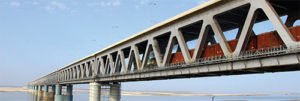 Spherical Bearings with four support system as per European bearing standard EN- 1337 have been used in the Bogibeel Bridge. A total of 164 such bearings have been used to construct the bridge. Each span is supported by four spherical bearings. These bearings had been manufactured by M/s. Maurer AG, Germany in accordance with the design finalized and approved by Ramboll / RITES.
Spherical Bearings with four support system as per European bearing standard EN- 1337 have been used in the Bogibeel Bridge. A total of 164 such bearings have been used to construct the bridge. Each span is supported by four spherical bearings. These bearings had been manufactured by M/s. Maurer AG, Germany in accordance with the design finalized and approved by Ramboll / RITES.
Corrosion Protection Measures
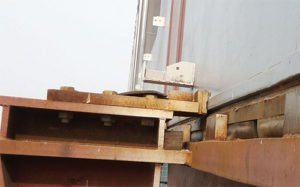 The superstructure of the Bridge has been constructed using a special grade copper-bearing steel plates in order to reduce corrosion. The average annual relative humidity in Bogibeel is 90% which goes up to 96% to 97%. To further reduce corrosions due to the excessive humidity, a complex Corrosion Protection System specific to different components of the bridge has been implemented during the construction of the bridge.
The superstructure of the Bridge has been constructed using a special grade copper-bearing steel plates in order to reduce corrosion. The average annual relative humidity in Bogibeel is 90% which goes up to 96% to 97%. To further reduce corrosions due to the excessive humidity, a complex Corrosion Protection System specific to different components of the bridge has been implemented during the construction of the bridge.
• Metal Spraying – Aluminum: Thermal Spray, basically known as Metallizing; is a process in which metal is melted and directly sprayed onto the surface of another metal to protect against corrosion, heat, traction, etc. Aluminum (Al) provides excellent corrosion resistance properties..
• For the Exterior of Bottom Chord, Bottom Joint & Bottom Cross Girder, Hot zinc spray has been carried out as a primer then Epoxy with MIO & TIO2 coating on it and Aliphatic Polyurethane coating has been carried out on the top of it.
• For Surfaces in contact with concrete that is the Top Chord and Top Joint, Metal Spray Zinc Coating of 80uM has been carried out.
• For Exterior of Top Chord, Top Joint, Top Cross Girders and Diagonals a primer of Inorganic Zinc Silicate having an intermediate coat of Epoxy with MIO and a top coat of Aliphatic Polyurethane has been carried out.
• For Interior of Bottom Chord, Bottom Joint, Top Chord, Top Joint, Top Cross Girder and Diagonals, a primer of zincrich epoxy having an intermediate coat of PVC with MIO and a top coat of Water-based Polyurethane was applied.
• And for Surface with concrete that is Top Cross Girder a final coat of Metal Spray Aluminum Coating was done again to ensure complete corrosion protection.
• Hot Dip Galvanizing: It is the process of coating iron & steel with zinc, which alloys with the surface of the base metal. It is done by immersing the metal in molten zinc at a temperature of around 840°F (449°C). Here a coating of 250 uM was applied to the Stringers & Bracings of the bridge.
• Also, all enclosed spaces were sealed by welding and were vacuum tested so that no air can go inside and initiate corrosion.
Seismic Restrainers
Location of Bogibeel Bridge falls in Seismic Zone-V which has been most vulnerable to earthquakes with magnitudes in excess of 7.0. In order to offer good stability to the heavy spans (1700 MT), they are provided with seismic restrainers.
This arrangement works like male & female connection with female pockets embedded on to piers and male parts arrangement on the span. For precise lowering of the span such that male joint fits into the female connections before the final lowering of the span on the permanent bearings, HCC team devised a unique circular slider frame made of stainless steel with jacks arrangement.
With this, the exact movement to fit the Seismic restrainers and final lowering of the heavy spans on permanent bearings were achieved.
Benefits of the Bridge
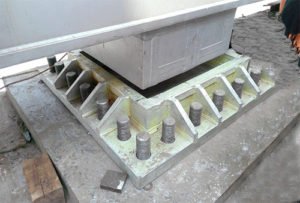 Defence Boost: The Bridge will be a big boost for the defence forces as it will provide rapid connectivity to areas near the India-China border. This means quicker movement of troops and heavy weapons systems.
Defence Boost: The Bridge will be a big boost for the defence forces as it will provide rapid connectivity to areas near the India-China border. This means quicker movement of troops and heavy weapons systems.
Time Savings: The biggest benefit is the time that it is going to save. As of now a train journey from Arunachal Pradesh to Assam’s Dibrugarh requires a 500 km detour via Guwahati. Now, the journey will be reduced to less than 100 Km. Also, the train journey between Delhi and Dibrugarh will also come down from 37 hours at present (via Guwahati) to 34 hours – a reduction of three hours.
Direct access to districts of Upper Assam: The bridge will provide direct access to the districts of Upper Assam from the rest of the country through the North bank and will do away the need to take tortuous route through Guwahati in the South bank.
Boost Tourism: Tourist places of Arunachal Pradesh will become more accessible and give a fillip to the tourism industry. The bridge will also cut down the distance to the border with China by 10 hours.
Better Medical Facilities: Dibrugarh district also houses prestigious Assam Medical College. The bridge will benefit the intra/inter-state transportation of medical patients seeking treatment in Dibrugarh. Currently, if any emergency of super speciality kind arises along the northern bank, the patients need to rely on boat ferries for transportation which can be very cumbersome and dicey.
Economic Benefits: The bridge, by connecting two very important highways of Assam namely the NH37 and NH52, will contribute in enhancing the intra-state and inter-state trade ecosystem. At present, any cargo generated on both the sides consumes at least 10 to 12 hours before it reaches its destination.
The Bogibeel Rail-Road link will significantly reduce this trans-shipment time and will take maximum two hours, thus saving the unnecessary extra cost of transportation and time too.
 TrafficInfraTech Magazine Linking People Places & Progress
TrafficInfraTech Magazine Linking People Places & Progress


